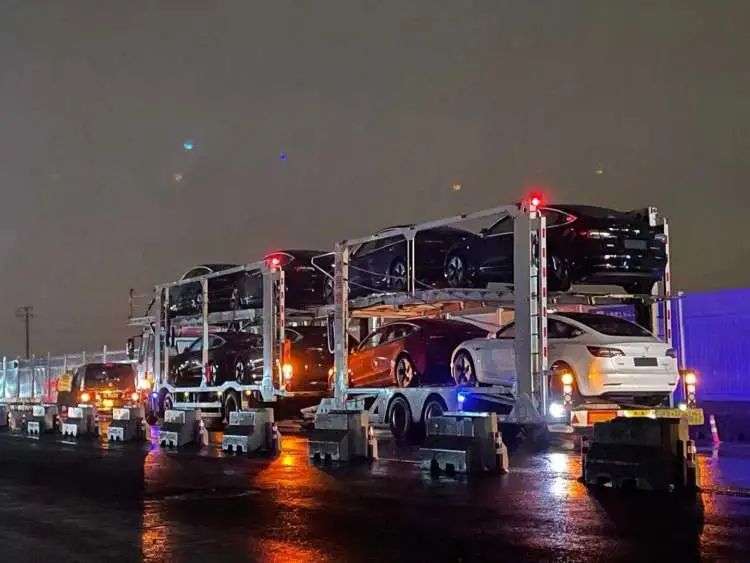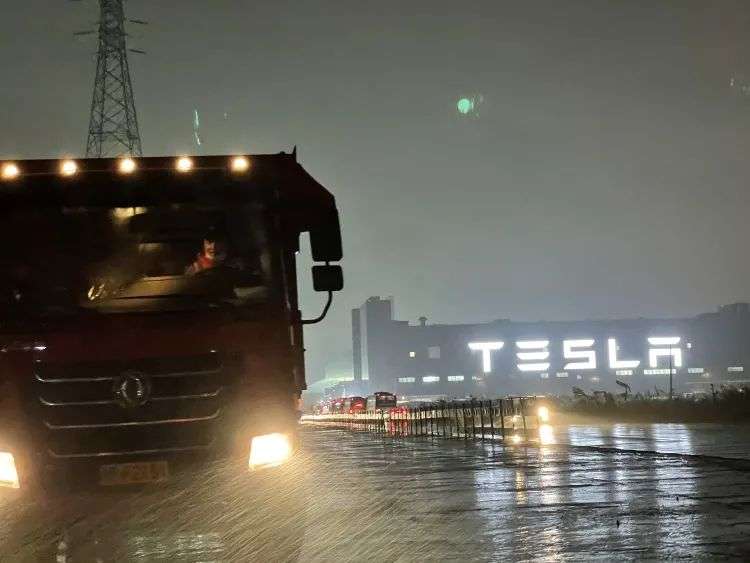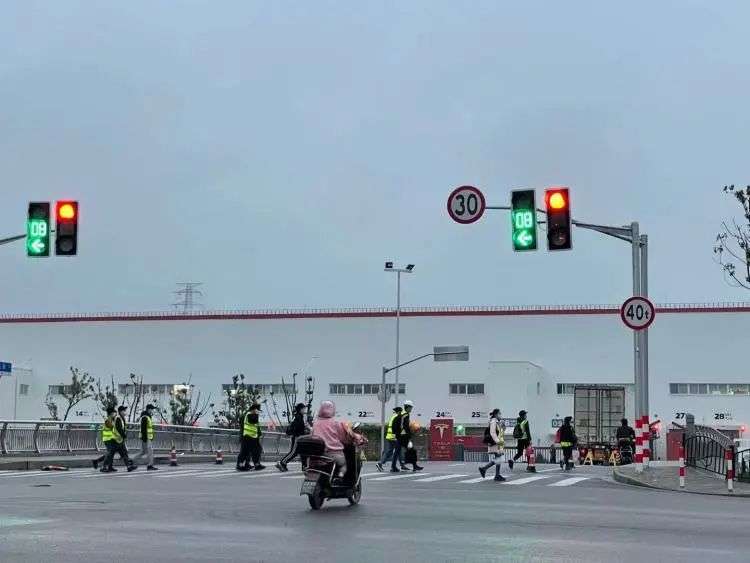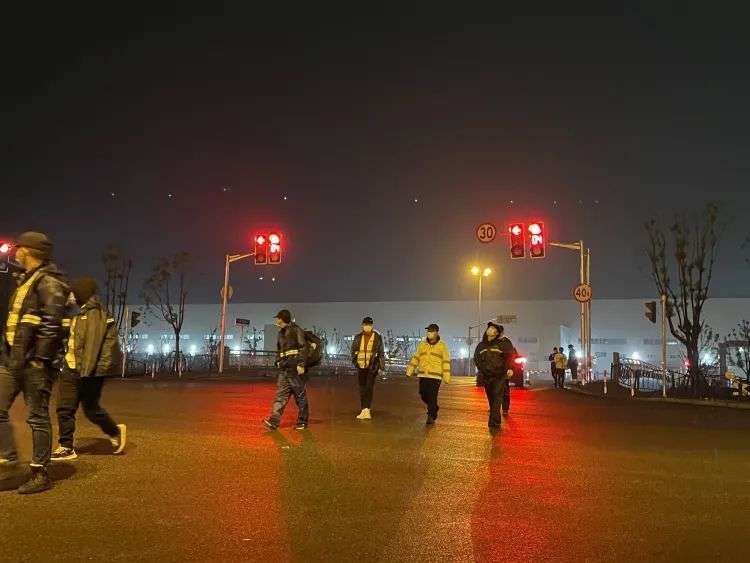Unqualified parts were loaded into the car, there was no robotic arm but the assembly worker’s workshop, the office where the contractor culture prevailed, and Musk, who kept himself in the dark.
Editor’s note: This article is from the micro-channel public number “goods play” (ID: pinwancool), Author: Chen Ke core, Editor: mysterious Ning.
Reference reading:
Tesla China’s Chaos Revealed Season 1 (click to view)
Tesla China’s Chaos Revealed Season 2 (click to view)
When the plane landed at Shanghai Pudong Airport, the sharp corners of the land extending to the ocean can be seen through the clouds; lower, the unique circular lake dripping lake area at the tip of the sharp corners of land is faintly visible. This is the main urban area of Shanghai Lingang. Going 20 kilometers southwest from here is the “Tesla Shanghai Super Factory”.
Surrounded by a vast and undeveloped farmland, the Tesla factory, covering an area of 860,000 square meters, is running around the clock. Heavy trucks are full of different colored Tesla cars that have just rolled off the assembly line. From here to all of China and the world.
On July 13, 2018, Tesla signed a contract with the Shanghai Municipal Government to announce that the “Super Factory” will be located in Shanghai Lingang. In January 2019, the factory was officially put into construction. In December of the same year, the first batch of Model 3 produced by the Shanghai factory was delivered. By October 2020, the Model 3 that went offline from here even began to export to Europe.
Everything is perfect “Chinese speed”.
Outside the Tesla Super Factory in Shanghai, a double-decker trailer transporting new cars from the factory (picture source: Pinwan)
The red double-decker trailers carrying Tesla off-line cars are separated from each other. There are also white buses carrying Tesla employees and workers who live in nearby rental houses and commute on foot. In the upcoming 2020, Tesla’s stock price has risen six times, and the third quarter is the best financial report in history. The production of cars in the quarter increased by 51% year-on-year and over 65% month-on-month, reaching 145,000. In the United States is still shrouded by the new crown virus, the European new crown virus has mutated, and Tesla’s manufacturing in the United States has fallen into “capacity hell” and cannot extricate itself from it.The employees of the Shanghai Gigafactory in bare clothing and helmets allowed Tesla to complete the ramp of production capacity.
Tesla’s China speed has driven Tesla’s stock price madness in 2020. As of December 23, 2020, Tesla’s market value has exceeded $610 billion. Wall Street and Silicon Valley are very excited about Tesla and see it as a light that changes the world. But what the New York and Silicon Valley elites never try to pay attention to is that what happened in the “miracle” and brightly lit Tesla factory in Shanghai is far from the vision of “changing the world”.
At night with heavy rain, heavy trucks filed out of Tesla’s Shanghai Super Factory (Photo source: Pinwan)< /p>
Disappearing substandard parts
“In order to complete production, Tesla is unscrupulously lowering its own quality standards,” a number of Tesla China insiders told Pinwan.
An employee whose work involves warehouse and logistics has discovered more than once that substandard parts disappear inexplicably.
The reason for the disappearance of these substandard parts is in extremely strong contrast with the “high-tech image” that Tesla has always created: Generally speaking, manufacturing companies use the SAP system to manage the transportation and circulation of factory products. Tesla used it briefly, but it was later deactivated because it was “too expensive and had to pay a lot of money every year”.
After disabling the SAP system, Tesla’s own IT department “copyed” a similar software system, “it’s not smart at all,” people familiar with the matter told Pinwan.
This has led to the automatic acceptance, transportation and assembly of parts that could be completed by the system, but a lot of manual loading is required. One consequence of this is that the accuracy of warehouse inventory has become a mess.
Due to the inaccuracy of the system, workers naturally cannot judge whether the parts are qualified. In the final inventory, I wanted to trace where the broken parts went, only to find that they could not be found.
The above insiders speculated that these bad parts may have been loaded into the car.
Not only is the assembly process out of control, Tesla’s components even have problems at the root cause.
The pursuit of speed has a cost. The huge production pressure makes it unbearable for suppliers. “It can’t be supplied at all, it’s uncomfortable.” A specialSla’s supplier said. When the demand for output reaches a critical point, the price will be a sacrifice in quality. “The solution is very simple and rude, which is to bring the problematic parts, that is, defective products, directly online.”
This statement has been recognized by several suppliers. They even stated that it is already an “open secret” in the industry.
Tesla’s internal quality department employees also feel this change. An employee told Pinwan that in Tesla’s open office area, I often hear everyone’s comments: As the quality of parts and components has declined, there are many problems with cars built in the Shanghai factory, and the quality standard scores have been declining accordingly. If released according to the original standard, no car will pass the quality inspection. But their solution is not to improve quality. Instead, the factory standard after a complete vehicle inspection is lowered.
“For example, it used to take 80 points to leave the factory, but now it takes 60 points,” Tesla insiders told Pinwan.
Some Tesla engineers lamented that although the exterior looks like Tesla, but the quality control, the craftsmanship accuracy is not even a little bit worse. “This (Shanghai factory) car is completely another car. It’s a defective product.”
Safety hazards accumulate in these links, and Tesla China’s management team has made the problem worse.
Previously, some Model S had the problem of protruding front ball head bolts. This is a high-end Tesla model, priced between 700-1.2 million yuan. In extreme cases, this will cause the ball-end cone seat to fall out of the steering knuckle, affecting the control of the vehicle and increasing the risk of accidents. .
But after the problem occurred, at a weekly meeting, Xue Juncheng, Tesla after-sales service director in Greater China, said:
“We can’t recall. We can secretly replace the owner’s car after it is found that there is a problem with him.” He said at the meeting: “For example, when the car comes for maintenance or when the owner requests a replacement, it can be replaced.”
Passed layer by layer, when facing car owners, this quality problem has become a “free upgrade” in Tesla’s official after-sales language.
At a later meeting, Xue Juncheng also quoted an internal statistical data, saying that more than 100 Model S models had been found to have the same problem. Industry insiders explained that, affected by the frequency of use, problems with front ball studs do include probability factors, but more than one hundred vehicles are no longer a small number.
An old Tesla employee who attended the meeting told Pinwan: The same problem was discovered and raised as early as 2017, but in order to delay the recall and avoid excessive costs, there has been no public solution. . It can be seen that the quality problems of Tesla’s production in China are deeply influenced by the consistent attitude of its headquarters.
In fact, Tesla has only conducted three vehicle recalls in the Chinese market, and all of them only involve imported models. Cars produced by the Shanghai plantNever been affected. Among them, on October 23, 2020, nearly 30,000 imported Model S and Model X were recalled due to the failure of the front suspension connecting rod of the vehicle, which was the largest recall in China.
But just after this recall, according to CNBC reports, when Tesla faced an inquiry from the National Highway Traffic Safety Administration (NHTSA), it said that they did not agree with the State Administration of Market The investigation conclusion of the production quality, instead, believes that the problem with the vehicle is caused by “Chinese car owners abuse” and spills “dirty water” back on Chinese users.
However, it is somewhat ironic that Tesla’s official voice has not yet come. In November 2020, NHTSA stated that it will formally investigate the defects of the front suspension of 110,000 Tesla vehicles.
At the same time, accidents caused by Tesla’s quality problems have emerged one after another, and they are frequently reported in the global media: the central control screen goes black without warning during driving, the vehicle is out of control during driving, and the roof leaks causing the cab to leak. Rain and horns rust, etc., and there have been several accidents that have caused casualties.
But these quality defects and potential safety hazards cannot stop Tesla’s yearning for production capacity and output. In fact, a very important consideration when Shanghai introduced the Tesla Gigafactory to settle down was to value the Tesla factory’s overall drive to the upstream manufacturing supply chain around Shanghai and its driving force for the development of higher-quality manufacturing in China. . However, Tesla does not seem to be too interested in “higher quality made in China”, and has little effort.
It only values productivity.
Entrance of Tesla Super Factory Shanghai (picture source: Pinwan)
Blood and Tears Factory
“Tesla’s current output is too high”, this is the unanimous evaluation of many Tesla employees and people in the automotive industry.
In October 2020, the Shanghai plant produced 22,900 vehicles. Compared with other high-end car brands entering China, the monthly production volume of Beijing Benz exceeded 20,000. It took 10 years for Beijing Benz to deliver a higher threshold. The two new domestic car manufacturers, the delivery data for one year , In order to catch up with the one-month production volume of Tesla’s Shanghai factory.
And these forcibly high production volumes do not rely on technological innovation. Most of the time, it is still a result of high-intensity manual laborfruit. This kind of high-intensity production quickly obliterated many workers in the Shanghai factory’s vision of Tesla. The rapidly shrinking benefits and increasingly harsh working environment have also completely discouraged workers.
The continuous improvement of productivity indicators has caused many businesses to abandon their original laws.
“When the plant was opened and constructed, the planned sewage treatment volume was completely different from the current one,” recalled Liu Zhuoli, an employee of the sewage treatment post. When he entered the factory, Tesla’s Shanghai factory had just started operation for three months. If the normal production was followed, the sewage treatment capacity was sufficient. As the output climbed, he found that his rest time was decreasing.
Finally, humans and machines are overloaded at the same time and can’t handle that much sewage. One night, the leader suddenly came over and said that today’s sewage treatment volume will be tripled, “How to deal with it is your business, anyway, as long as the discharge reaches the standard.”
Liu Zhuoli was very distressed. He was only recruited into the factory as an operator, not an engineer. But the leadership’s instructions were very tough, “I can’t figure out how to improve the equipment, right? Then everyone don’t get off work together.”
Starting at 5 pm, the leader and the entire department “sit together”. At 11 o’clock in the evening, some employees who could not hold it finally spoke, “I figured it out,” and the leader let him go home tomorrow.
However, there is no real solution.
Liu Zhuoli couldn’t help but remember that when the last factory encountered a production problem and needed to work overtime, the leader would bring snacks to everyone, call out everyone’s name, and gently said, “Maybe we will have to work overtime tonight. “The experienced master would say to him, “Smelly boy, I’ll make dumplings for you tonight.” His heart warmed and he shouted on the walkie-talkie, “Master, let the work go, I’ll do it.”
But Tesla does not have dumplings, and even snacks. At 8:30 every night, Tesla employees who work overtime will have an extra meal. The first is a box lunch, which is later changed to instant noodles, and finally it is directly replaced with bread that is convenient to store and eat. “You don’t even have to drink hot soup “.
Gradually, workers no longer expect to eat Western food, Chinese food, Malaysian food, Thai food, and Japanese food in turns like the foreign-invested factories they worked in before. There was not enough staple food in the box lunch, so I asked Dafan auntie to give me more buns. I was refused. I ate instant noodles and had “acid water in my stomach”. The bread that I sent out was out of date. “A colleague made trouble.” Still nothing.
At seven o’clock in the morning, Tesla employees on the morning shift (photo source: Pinwan)
Like most manufacturing factories in China, the production lines of Tesla’s Shanghai factory are also operated in three shifts, running 24 hours a day. A shift is 12 hours, which means that it takes a long time to stand and work, and one part needs to be installed in a few minutes. Under this kind of work intensity, it is impossible to focus on other places. I will continue to work in a while.”
Sometimes Liu Zhuoli will be sad and angry. “To put it bluntly, we are not regarded as adults. We are laborers and tools. We are just a robotic arm that can walk, eat, and shit!”
He still remembers that when the Shanghai factory just opened, there were hundreds of people waiting for interviews to enter the factory every Saturday morning. The mighty team could extend for several kilometers, all of them from BYD, SAIC, Volkswagen and other industry factories. Came to apply. At that time, Tesla China was famous for its high wages. In addition to the basic salary and stocks, there were overtime subsidies. In many cases, overtime subsidies could reach one-third of the basic salary, and first-line blue-collar workers could get more than 10,000 yuan every month.
But then the benefits began to be cancelled. First, the overtime pay was rumored to be cancelled, and the time off was not able to choose the time voluntarily. This led to the resignation of a large number of employees in the production department. In a week, nearly 100 people left. The production line was even forced to stop. The three shifts were changed to two shifts due to insufficient staff. inverted.
At five o’clock in the morning, Tesla employees leaving the night shift (picture source: Pinwan)
Furthermore, after entering the Shanghai factory, the workers discovered that it is not as advanced as the cool promotional videos released by Tesla China.
“Go to the factory and take a look at the difference between the sky and the ground.” In Tesla China’s external propaganda, there are many animations inside the workshop, with huge and uniform robotic arms standing on both sides of the production line. In the middle are the vehicles coming from the conveyor belt waiting to be assembled. But an employee working in the workshop said that this is just what Tesla China wants the outside world to see.
Like traditional cars, Tesla also has four workshops-stamping, welding, painting and final assembly. The difference is that there is an additional battery workshop. “The most messy thing is the assembly workshop. There are many people on site. It is very difficult to squeeze and turn around. There are materials and people next to them, and they rely on people to install.” The above-mentioned person said.
But many workers still persist.
“What is the only thing we are happy about? Stocks!” This is the unanimous answer from several Tesla employees who do not know each other.
For them, the most anticipated time of the day is when the U.S. stock market opens after nightfall, and then take out the phone and put it on the table, praying that the line representing the rise and fall of stocks will go up and then up.
In the past at Tesla China, regardless of position and rank, every employee who entered the job was able to get a certain amount of stock, including workshop workers and store salespersons, in the ever-cutting benefits and increasingly harsh working environment Under the squeeze, stocks have become one of their biggest motivations to encourage them to continue working. The stock lock-up period is one year, which means that if you leave within one year, you will lose this part of the stock, and the good expectations you once placed will also be lost.
The biggest turning point occurred in May 2020, when Tesla China formally cancelled the equity incentive system for ordinary employees.
Not even the last thought.
Tesla’s reputation in the circle has begun to deteriorate, and labor outsourcing companies that have worked with in the past are no longer willing to recommend workers.
The head of a labor outsourcing company 4.5 kilometers away from Tesla said to the author of Pinwan who came to “apply for” workers: “I really don’t recommend that you go to Tesla. This company just blows up well. In fact, it’s not easy to do the job. Many people who recommended it in, because they couldn’t stand their management methods, they jumped out after a while.
According to the workers’ report, what the leader likes to say is-do what you can, and leave if you can’t. “The quality of those leaders is uneven, and the speeches are more ugly. It is nothing to say once or twice. If you say this kind of words ten times or eight times, the taste has changed,” said the person above.
The late-night roadside stall outside Tesla Super Factory Shanghai (picture source: Pinwan)
This sentiment spreads among front-line workshop employees, and the quality of work that requires manual hands-on is inevitably affected.
“Brother, this car window is not closed tightly”, a front-line employee in charge of facility operations reminded on the intercom. He has worked in a number of manufacturing factories. Based on past experience, the windows of the car must be closed when leaving the factory, “at least the appearance must be created.” But at Tesla, he received a careless response from the walkie-talkie, “We will shut it down.” After 15 minutes, no one came to the scene to deal with it.
By every month





